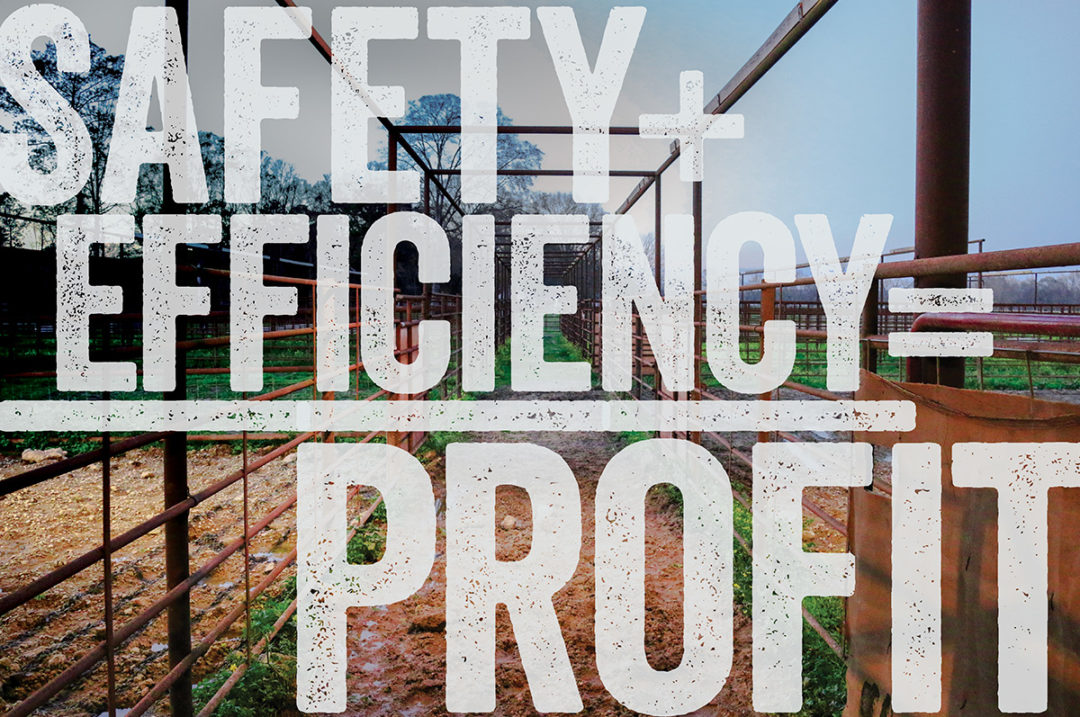Spring is peeking around the corner, which announces itself with a host of tasks to complete. Branding, doctoring and turning pairs out are just a few examples of the responsibilities ranchers must undertake as the snow begins to melt. In order to maximize economic return, producers need to strategically balance factors introduced by different types of animal-handling facilities. The decisions made in the area of equipment management directly affect profitability, which is why focus is necessary when reviewing herd information amid the stresses of managing a cattle operation.
In a webinar included in the Texas & Southwestern Cattle Raisers Association’s Ranching 101 series, Cody Duncan, an accounts manager with Priefert Manufacturing, introduced the importance of using the equipment equation, which consists of adding safety and efficiency together in order to maximize profitability.
“Whenever you put these two things together, your safety and efficiency, that’s going to equal your profit,” Duncan said. “Healthier animals, safety and being able to work them quickly, from the catch to the sweep, down the alley and to your squeeze chute, that is going to save you time, money, labor and, of course, it’s just going to improve your bottom line.”
Before further discussing specific decisions with equipment, Duncan encouraged listeners to categorize and manage equipment in two different categories. “There’s really two aspects of your operation, and that’s going to be items that you need to maintain your nutrition program, and the other part is going to be your handling equipment.” According to Duncan, balancing the attention focused on the safety and efficiency for both nutrition and handling equipment will culminate in the best possible outcome for the operation.
Capitalizing on nutrition
Duncan advised producers to “keep it vague” when taking inventory of equipment already on an operation. By examining only major pieces of equipment, producers are able to discover and highlight characteristics that benefit safety or efficiency and identify possible aspects that need further attention or replacing. Prioritizing the most vital tools and implements allows producers to apply more energy to the tasks that need accomplished each day, resulting in a balanced flow of attention and consideration to the entire operation.
“In the nutrition program, you’re going to see a couple different kinds of equipment that we think is probably pretty important,” started Duncan. “These things are going to supplement these animals to help them survive and thrive during certain situations.” The pieces of equipment Duncan referred to consists of the following:
- Mineral feeders
- Water sources
- Forage feeders
- Bunk feeders
- Creep feeders
Duncan urged listeners to develop a stabilized system as none of the types of equipment discussed can be adequately evaluated in a short time frame. This is especially true for water sources, as Duncan explained. “The thing you need to remember is that a cow, with the rumen and the fermentation that happens there, they need at least 80 percent of good moisture in their gut in order to be effective at breaking down their forage, feed and supplements you have provided for them.”
Though water is a vital component to an operation’s nutrition program and requires thorough analysis of its safety and efficiency, balancing the upgrades and needs of each type of equipment is key. “The reason why all these items are very important is because you need the right equipment to assist your animals,” said Duncan. “Without it, it can create a ripple effect and really affect things like your breeding back, conception rates or making sure a cow can support itself and its calf.”
Capitalizing on handling
“With your handling equipment, there is no ‘one-size-fits-all,’ since we are all different sizes, budgets and all that kind of stuff,” said Duncan. “Really, you just have to choose what you can live without and what you can’t live without.” Within the handling category of an operation, the necessity for implements shifts perspectives as additional material creeps over from “needs” to “wants.” In order to maximize safety and efficiency with handling equipment, Duncan advised listeners to “mix and match” options in order to create the most profitable outcome.
When analyzing handling equipment and making decisions about what is necessary on an operation, Duncan suggested moving through the system piece by piece. “We’re going to work our way backwards,” Duncan told listeners. “Go from your chute, where the most pressure on an animal is applied, to the sweep, the alley, to your sorting pens and then where pressure is less: your loadouts.” This piece-by-piece analysis consists of several details within equipment categories, including:
- Headgate or squeeze chute
- Calf table
- Scales
- Palpation cage
- Panels
- Corrals
- Panels (open or sheeted)
- Design
By following this list in evaluating handling equipment, producers are able to determine what characteristics are missing in order to eventually make a calculated decision on how to maximize profitability.
“Cost, of course, is relative,” said Duncan. “Cool stuff and good stuff isn’t always cheap. That’s why a Cadillac has a Cadillac price. It’s because you’re paying for the features and the benefits.” Duncan encouraged listeners to take note of and focus on what features and benefits specific aspects of handling equipment could alter safety and efficiency, such as durability and adaptability. “Is it going to fit my needs? Will it last? Can I use it with different brands?”
“Once you’ve got all this stuff figured out, what you want and/or need, that’ll tell you how you need to set it up,” Duncan said. “This is what you want to do on your place … make a good, easy flow where animals can come in, get moved around, then get out and go about their business. Do it all as quick and efficient as you possibly can.”
Within both the handling and nutrition programs on an operation, Duncan emphasized the need for careful evaluation and analysis, reviewing equipment needs and assessing the safety and efficiency in order to fully capitalize on profit, which are the key elements to the “equipment equation.”
For more information on maximizing economic return with equipment, you can watch the full webinar by following the “Cattle Raisers” channel on YouTube.








